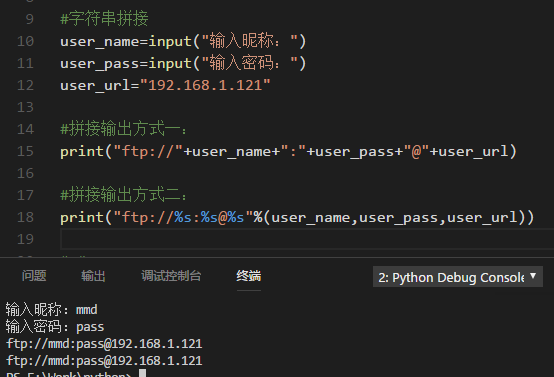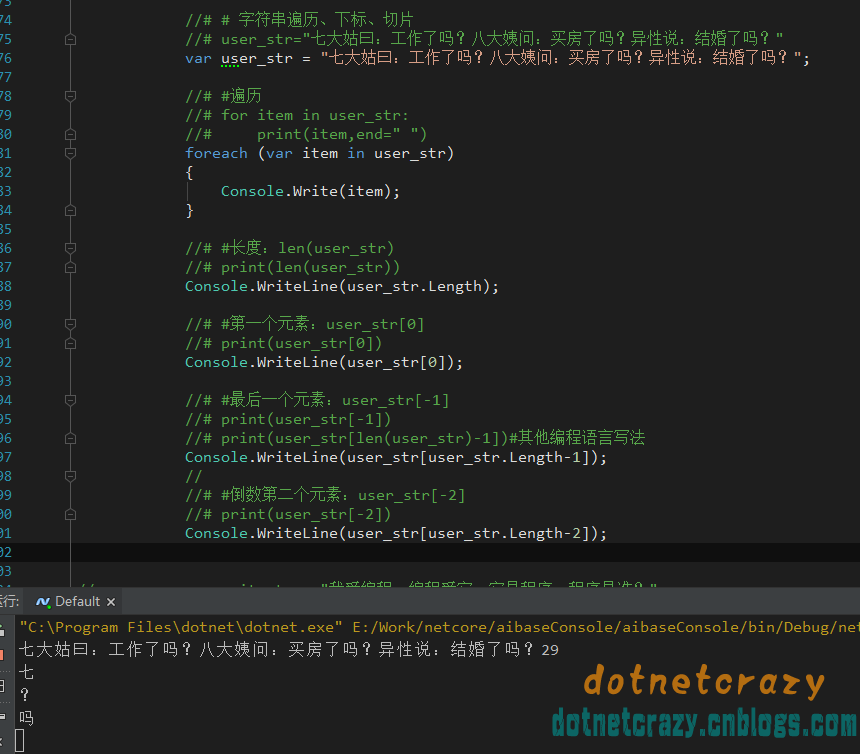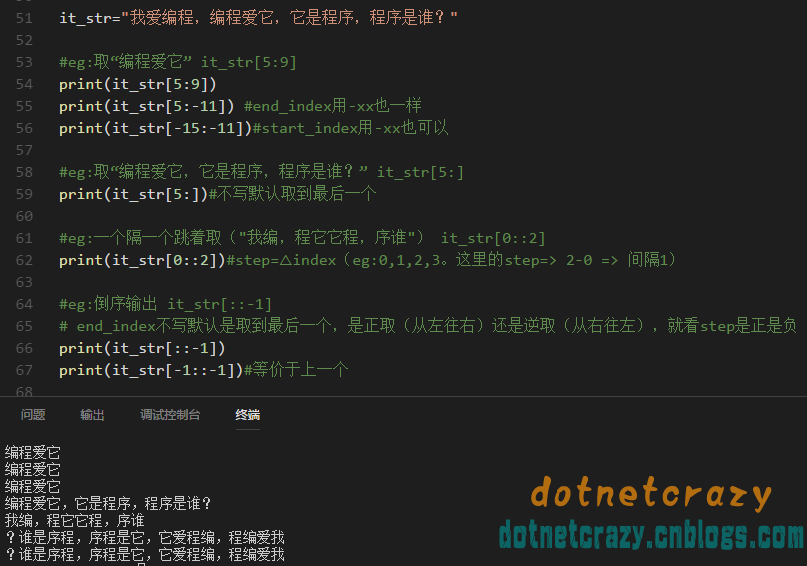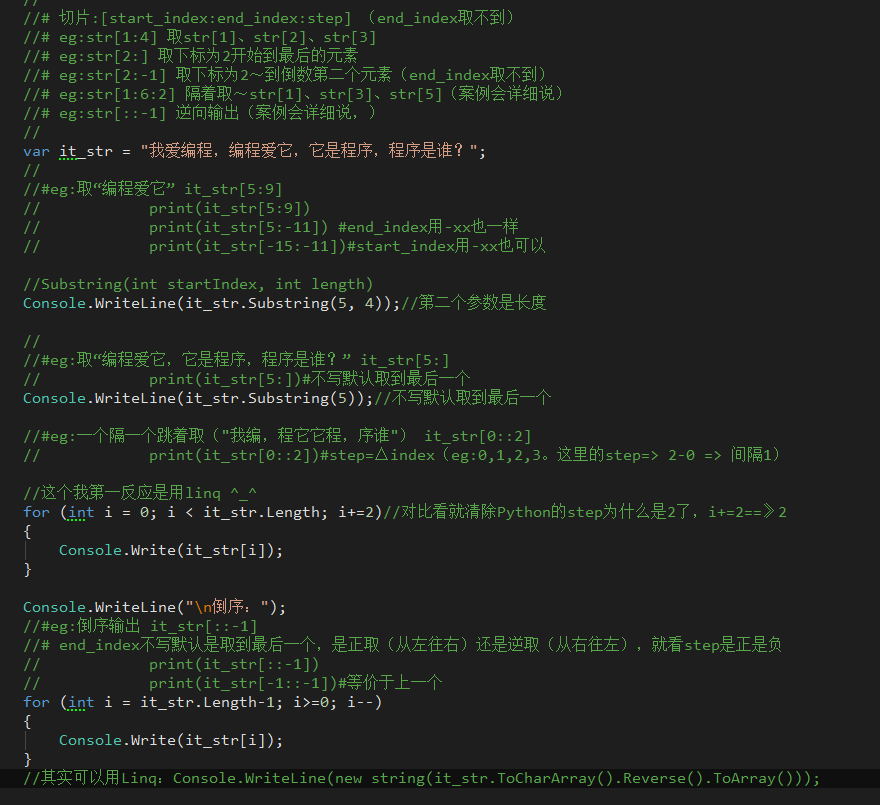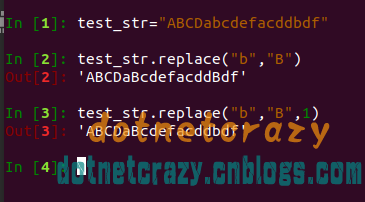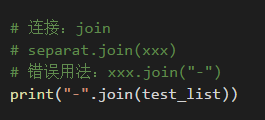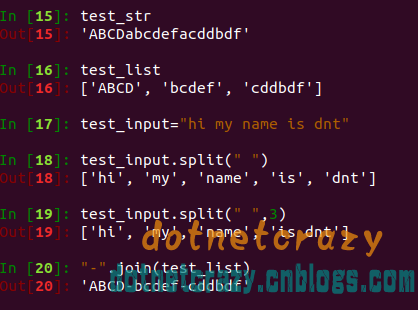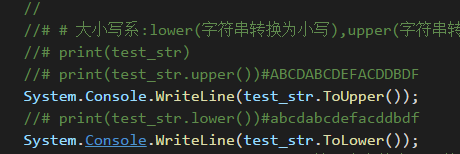Python3 与 C# 基础语法对比:https://www.cnblogs.com/dotnetcrazy/p/9102030.html
事先声明一下,避免让新手进入误区:不是说Python比NetCore要好,而Python设计的目的就是==》让程序员解放出来,不要过于关注代码本身,那么性能、规范等等各方面隐患就存在了,后面编写一个稍微大点的项目就看出来了。而且不要太受语言约束,之前我也说过,用各自语言的优势来为项目服务~ 这才是开发王道。比如Python用来数据分析,Go用来并发处理等等,不多说了,记住一句话即可:“Net是性价比最高的”
步入正题:欢迎提出更简单或者效率更高的方法
基础系列:(这边重点说说Python,上次讲过的东西我就一笔带过了)
1.输出+类型转换Python写法:
NetCore:
2.字符串拼接+拼接输出方式
python:
NetCore
3.字符串遍历、下标、切片
重点说下python的下标,有点意思,最后一个元素,我们一般都是len(str)-1,他可以直接用-1,倒2自然就是-2了
#最后一个元素:user_str[-1]user_str[-1]user_str[len(user_str)-1] #其他编程语言写法#倒数第二个元素:user_str[-2]
这次为了更加形象对比,一句一句翻译成NetCore(有没有发现规律,user_str[user_str.Length-1]==》-1是最后一个,user_str[user_str.Length-2]==》-2是最后一个。python在这方面简化了)
3.2 python切片语法:[start_index:end_index:step] (end_index取不到)
# 切片:[start_index:end_index:step] (end_index取不到) # eg:str[1:4] 取str[1]、str[2]、str[3] # eg:str[2:] 取下标为2开始到最后的元素 # eg:str[2:-1] 取下标为2~到倒数第二个元素(end_index取不到) # eg:str[1:6:2] 隔着取~str[1]、str[3]、str[5](案例会详细说) # eg:str[::-1] 逆向输出(案例会详细说,)来个案例:我注释部分说的很详细了,附录会贴democode的
NetCore,其实你用Python跟其他语言对比反差更大,net真的很强大了。补充(对比看就清楚Python的step为什么是2了,i+=2==》2)
方法系列:
# 查找:find,rfind,index,rindexPython查找推荐你用 find和rfind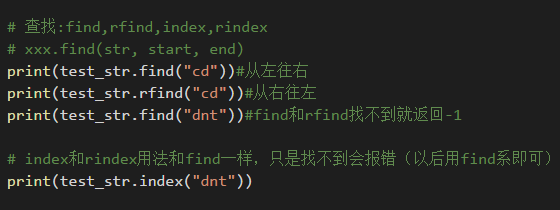 netcore: index0f就相当于python里面的 find
netcore: index0f就相当于python里面的 find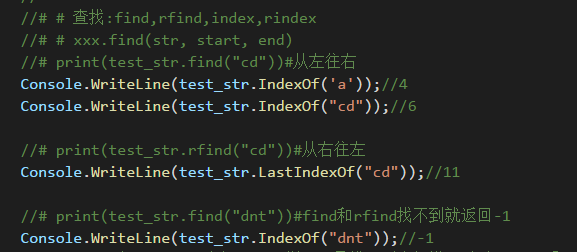
# 计数:countpython: str.count() netcore:这个真用基础来解决的话,只能自己变形一下: (原字符串长度 - 替换后的长度) / 字符串长度
netcore:这个真用基础来解决的话,只能自己变形一下: (原字符串长度 - 替换后的长度) / 字符串长度 Python补充说明:像这些方法练习用 ipython3就好了( sudo apt-get install ipython3),code的话需要一个个的print,比较麻烦(我这边因为需要写文章,所以只能一个个code)
Python补充说明:像这些方法练习用 ipython3就好了( sudo apt-get install ipython3),code的话需要一个个的print,比较麻烦(我这边因为需要写文章,所以只能一个个code)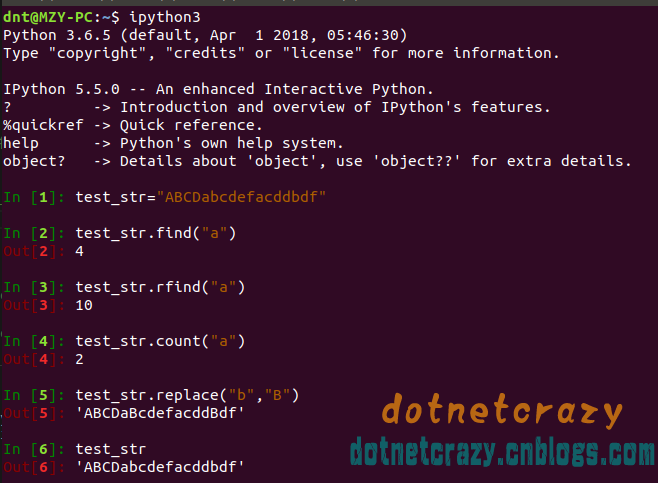 index查找不到会有异常
index查找不到会有异常
# 替换:replacePython: xxx.replace(str1, str2, 替换次数) replace可以指定替换几次
replace可以指定替换几次
NetCore:替换指定次数的功能有点业余,就不说了,你可以自行思考哦~
#连接:join:eg:print("-".join(test_list))
netcore:string.Join(分隔符,数组)

#分割:split(按指定字符分割),splitlines(按行分割),partition(以str分割成三部分,str前,str和str后),rpartition
说下split的切片用法 :print(test_input.split(" ",3)) #在第三个空格处切片,后面的不切了
继续说说 splitlines(按行分割),和split("\n")的区别我图中给了案例扩展: split(),默认按空字符切割(空格、\t、\n等等,不用担心返回'')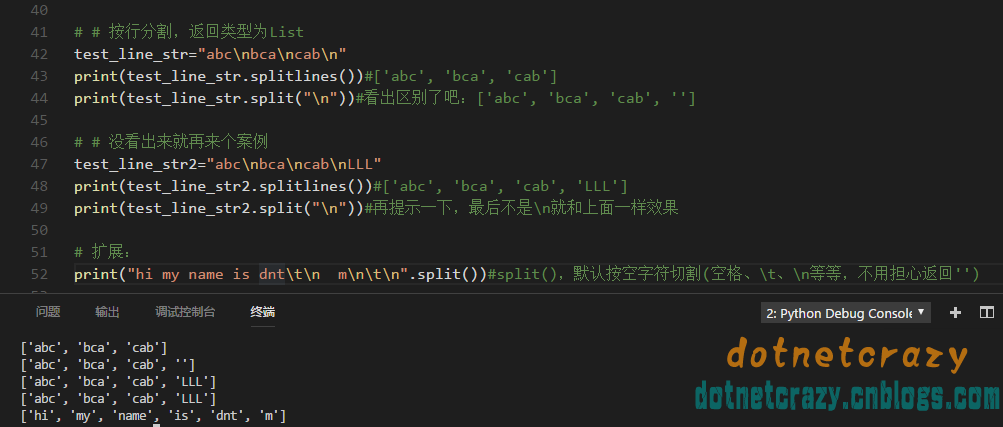 最后说一下 partition 和 r partition 返回是元祖类型(后面会说的),方式和find一样,找到第一个匹配的就罢工了【注意一下没找到的情况】
最后说一下 partition 和 r partition 返回是元祖类型(后面会说的),方式和find一样,找到第一个匹配的就罢工了【注意一下没找到的情况】 netcore: split里面很多重载方法,可以自己去查看下,eg:Split("\n",StringSplitOptions.RemoveEmptyEntries)再说一下这个: test_str.Split('a');//返回数组。如果要和Python一样返回列表==》test_str.Split('a').ToList(); 【需要引用linq的命名空间哦】
netcore: split里面很多重载方法,可以自己去查看下,eg:Split("\n",StringSplitOptions.RemoveEmptyEntries)再说一下这个: test_str.Split('a');//返回数组。如果要和Python一样返回列表==》test_str.Split('a').ToList(); 【需要引用linq的命名空间哦】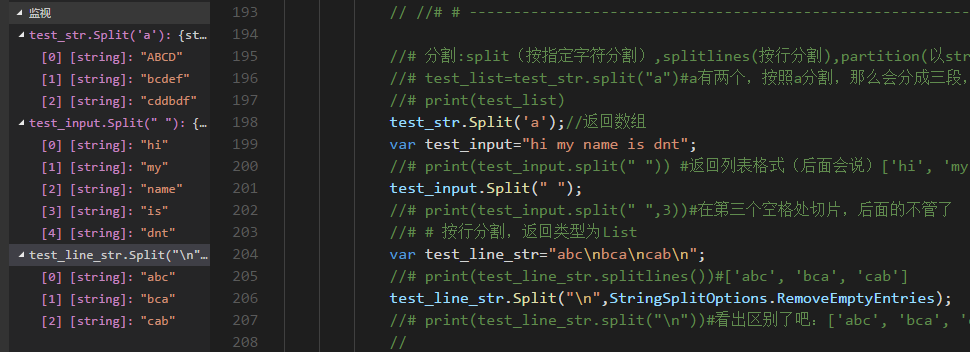
# 头尾判断:startswith(以。。。开头),endswith(以。。。结尾)
netcore:
# 大小写系:lower(字符串转换为小写),upper(字符串转换为大写),title(单词首字母大写),capitalize(第一个字符大写,其他变小写)
netcore:
# 格式系列:lstrip(去除左边空格),rstrip(去除右边空格),strip(去除两边空格)美化输出系列:ljust,rjust,center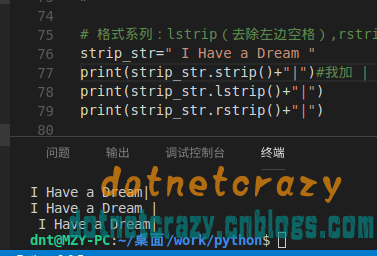
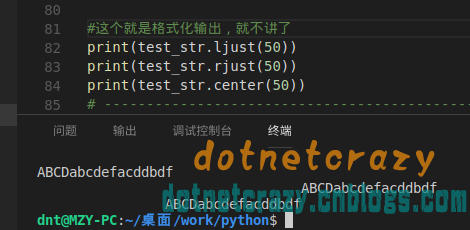 netcore: Tirm很强大,除了去空格还可以去除你想去除的任意字符
netcore: Tirm很强大,除了去空格还可以去除你想去除的任意字符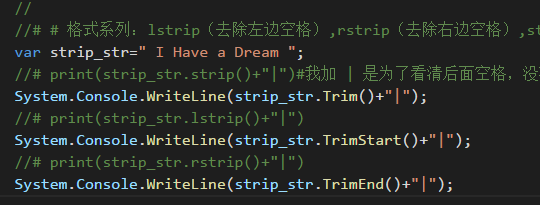 ljust,rjust,center这些就不说了,python经常在linux终端中输出,所以这几个用的比较多。net里面 string.Format各种格式化输出,可以参考
ljust,rjust,center这些就不说了,python经常在linux终端中输出,所以这几个用的比较多。net里面 string.Format各种格式化输出,可以参考
# 验证系列:isalpha(是否是纯字母),isalnum(是否是数字|字母),isdigit(是否是纯数字),isspace(是否是纯空格)一张图搞定,其他的自己去试一试吧,注意哦~ test_str5=" \t \n " #isspace() ==>true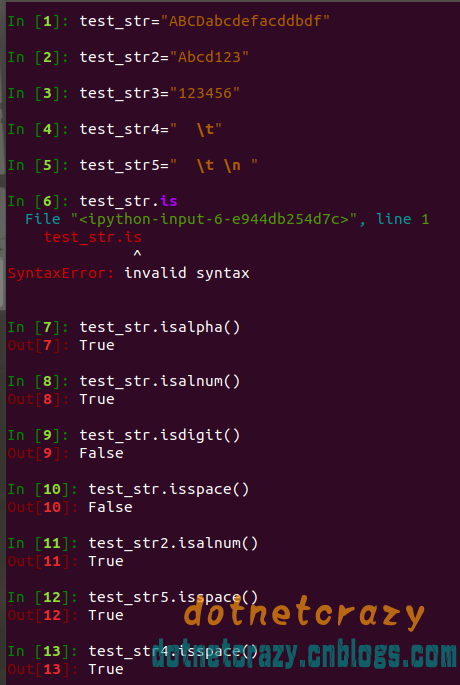 netcore: string.IsNullOrEmpty 和 string.IsNullOrWhiteSpace 是系统自带的,其他的你需要自己封装一个扩展类(eg:简单封装)【附录有】
netcore: string.IsNullOrEmpty 和 string.IsNullOrWhiteSpace 是系统自带的,其他的你需要自己封装一个扩展类(eg:简单封装)【附录有】
附录:
 View Code# #输出+类型转换 # user_num1=input("输入第一个数:") # user_num2=input("输入第二个数:") # print("两数之和:%d"%(int(user_num1)+int(user_num2))) # # ------------------------------------------------------------ # #字符串拼接 # user_name=input("输入昵称:") # user_pass=input("输入密码:") # user_url="192.168.1.121" # #拼接输出方式一: # print("ftp://"+user_name+":"+user_pass+"@"+user_url) # #拼接输出方式二: # print("ftp://%s:%s@%s"%(user_name,user_pass,user_url)) # # ------------------------------------------------------------- # # 字符串遍历、下标、切片 # user_str="七大姑曰:工作了吗?八大姨问:买房了吗?异性说:结婚了吗?" # #遍历 # for item in user_str: # print(item,end=" ") # #长度:len(user_str) # print(len(user_str)) # #第一个元素:user_str[0] # print(user_str[0]) # #最后一个元素:user_str[-1] # print(user_str[-1]) # print(user_str[len(user_str)-1])#其他编程语言写法 # #倒数第二个元素:user_str[-2] # print(user_str[-2]) # # ------------------------------------------------------------- # 切片:[start_index:end_index:step] (end_index取不到) # eg:str[1:4] 取str[1]、str[2]、str[3] # eg:str[2:] 取下标为2开始到最后的元素 # eg:str[2:-1] 取下标为2~到倒数第二个元素(end_index取不到) # eg:str[1:6:2] 隔着取~str[1]、str[3]、str[5](案例会详细说) # eg:str[::-1] 逆向输出(案例会详细说,) it_str="我爱编程,编程爱它,它是程序,程序是谁?" #eg:取“编程爱它” it_str[5:9] print(it_str[5:9]) print(it_str[5:-11]) #end_index用-xx也一样 print(it_str[-15:-11])#start_index用-xx也可以 #eg:取“编程爱它,它是程序,程序是谁?” it_str[5:] print(it_str[5:])#不写默认取到最后一个 #eg:一个隔一个跳着取("我编,程它它程,序谁") it_str[0::2] print(it_str[0::2])#step=△index(eg:0,1,2,3。这里的step=> 2-0 => 间隔1) #eg:倒序输出 it_str[::-1] # end_index不写默认是取到最后一个,是正取(从左往右)还是逆取(从右往左),就看step是正是负 print(it_str[::-1]) print(it_str[-1::-1])#等价于上一个 # # -------------------------------------------------------------
View Code# #输出+类型转换 # user_num1=input("输入第一个数:") # user_num2=input("输入第二个数:") # print("两数之和:%d"%(int(user_num1)+int(user_num2))) # # ------------------------------------------------------------ # #字符串拼接 # user_name=input("输入昵称:") # user_pass=input("输入密码:") # user_url="192.168.1.121" # #拼接输出方式一: # print("ftp://"+user_name+":"+user_pass+"@"+user_url) # #拼接输出方式二: # print("ftp://%s:%s@%s"%(user_name,user_pass,user_url)) # # ------------------------------------------------------------- # # 字符串遍历、下标、切片 # user_str="七大姑曰:工作了吗?八大姨问:买房了吗?异性说:结婚了吗?" # #遍历 # for item in user_str: # print(item,end=" ") # #长度:len(user_str) # print(len(user_str)) # #第一个元素:user_str[0] # print(user_str[0]) # #最后一个元素:user_str[-1] # print(user_str[-1]) # print(user_str[len(user_str)-1])#其他编程语言写法 # #倒数第二个元素:user_str[-2] # print(user_str[-2]) # # ------------------------------------------------------------- # 切片:[start_index:end_index:step] (end_index取不到) # eg:str[1:4] 取str[1]、str[2]、str[3] # eg:str[2:] 取下标为2开始到最后的元素 # eg:str[2:-1] 取下标为2~到倒数第二个元素(end_index取不到) # eg:str[1:6:2] 隔着取~str[1]、str[3]、str[5](案例会详细说) # eg:str[::-1] 逆向输出(案例会详细说,) it_str="我爱编程,编程爱它,它是程序,程序是谁?" #eg:取“编程爱它” it_str[5:9] print(it_str[5:9]) print(it_str[5:-11]) #end_index用-xx也一样 print(it_str[-15:-11])#start_index用-xx也可以 #eg:取“编程爱它,它是程序,程序是谁?” it_str[5:] print(it_str[5:])#不写默认取到最后一个 #eg:一个隔一个跳着取("我编,程它它程,序谁") it_str[0::2] print(it_str[0::2])#step=△index(eg:0,1,2,3。这里的step=> 2-0 => 间隔1) #eg:倒序输出 it_str[::-1] # end_index不写默认是取到最后一个,是正取(从左往右)还是逆取(从右往左),就看step是正是负 print(it_str[::-1]) print(it_str[-1::-1])#等价于上一个 # # ------------------------------------------------------------- View Codetest_str="ABCDabcdefacddbdf" # ------------------------------------------------------------- # # 查找:find,rfind,index,rindex # # xxx.find(str, start, end) # print(test_str.find("cd"))#从左往右 # print(test_str.rfind("cd"))#从右往左 # print(test_str.find("dnt"))#find和rfind找不到就返回-1 # # index和rindex用法和find一样,只是找不到会报错(以后用find系即可) # # print(test_str.index("dnt")) # # ------------------------------------------------------------- # # 计数:count # # xxx.count(str, start, end) # print(test_str.count("a")) # # ------------------------------------------------------------- # # 替换:replace # # xxx.replace(str1, str2, count_num) # print(test_str) # print(test_str.replace("b","B"))#并没有改变原字符串,只是生成了一个新的字符串 # print(test_str) # # replace可以指定替换几次 # print(test_str.replace("b","B",1))#ABCDaBcdefacddbdf # # ------------------------------------------------------------- # 分割:split(按指定字符分割),splitlines(按行分割),,partition(以str分割成三部分,str前,str和str后),rpartition # test_list=test_str.split("a")#a有两个,按照a分割,那么会分成三段,返回类型是列表(List),并且返回结果中没有a # print(test_list) # test_input="hi my name is dnt" # print(test_input.split(" ")) #返回列表格式(后面会说)['hi', 'my', 'name', 'is', 'dnt'] # print(test_input.split(" ",3))#在第三个空格处切片,后面的不管了 # # 按行分割,返回类型为List # test_line_str="abc\nbca\ncab\n" # print(test_line_str.splitlines())#['abc', 'bca', 'cab'] # print(test_line_str.split("\n"))#看出区别了吧:['abc', 'bca', 'cab', ''] # # 没看出来就再来个案例 # test_line_str2="abc\nbca\ncab\nLLL" # print(test_line_str2.splitlines())#['abc', 'bca', 'cab', 'LLL'] # print(test_line_str2.split("\n"))#再提示一下,最后不是\n就和上面一样效果 # 扩展: # print("hi my name is dnt\t\n m\n\t\n".split())#split(),默认按空字符切割(空格、\t、\n等等,不用担心返回'') # #partition,返回是元祖类型(后面会说的),方式和find一样,找到第一个匹配的就罢工了 # print(test_str.partition("cd"))#('ABCDab', 'cd', 'efacddbdf') # print(test_str.rpartition("cd"))#('ABCDabcdefa', 'cd', 'dbdf') # print(test_str.partition("感觉自己萌萌哒"))#没找到:('ABCDabcdefacddbdf', '', '') # # ------------------------------------------------------------- # # 连接:join # # separat.join(xxx) # # 错误用法:xxx.join("-") # print("-".join(test_list)) # # ------------------------------------------------------------- # # 头尾判断:startswith(以。。。开头),endswith(以。。。结尾) # # test_str.startswith(以。。。开头) # start_end_str="http://www.baidu.net" # print(start_end_str.startswith("https://") or start_end_str.startswith("http://")) # print(start_end_str.endswith(".com")) # # ------------------------------------------------------------- # # 大小写系:lower(字符串转换为小写),upper(字符串转换为大写),title(单词首字母大写),capitalize(第一个字符大写,其他变小写) # print(test_str) # print(test_str.upper())#ABCDABCDEFACDDBDF # print(test_str.lower())#abcdabcdefacddbdf # print(test_str.capitalize())#第一个字符大写,其他变小写 # # ------------------------------------------------------------- # # 格式系列:lstrip(去除左边空格),rstrip(去除右边空格),strip(去除两边空格),ljust,rjust,center # strip_str=" I Have a Dream " # print(strip_str.strip()+"|")#我加 | 是为了看清后面空格,没有别的用处 # print(strip_str.lstrip()+"|") # print(strip_str.rstrip()+"|") # #这个就是格式化输出,就不讲了 # print(test_str.ljust(50)) # print(test_str.rjust(50)) # print(test_str.center(50)) # # ------------------------------------------------------------- # 验证系列:isalpha(是否是纯字母),isalnum(是否是数字|字母),isdigit(是否是纯数字),isspace(是否是纯空格) # test_str2="Abcd123" # test_str3="123456" # test_str4=" \t" # test_str5=" \t \n " #isspace() ==>true # 一张图搞定,其他的自己去试一试吧 # test_str.isalpha() # test_str.isalnum() # test_str.isdigit() # test_str.isspace()
View Codetest_str="ABCDabcdefacddbdf" # ------------------------------------------------------------- # # 查找:find,rfind,index,rindex # # xxx.find(str, start, end) # print(test_str.find("cd"))#从左往右 # print(test_str.rfind("cd"))#从右往左 # print(test_str.find("dnt"))#find和rfind找不到就返回-1 # # index和rindex用法和find一样,只是找不到会报错(以后用find系即可) # # print(test_str.index("dnt")) # # ------------------------------------------------------------- # # 计数:count # # xxx.count(str, start, end) # print(test_str.count("a")) # # ------------------------------------------------------------- # # 替换:replace # # xxx.replace(str1, str2, count_num) # print(test_str) # print(test_str.replace("b","B"))#并没有改变原字符串,只是生成了一个新的字符串 # print(test_str) # # replace可以指定替换几次 # print(test_str.replace("b","B",1))#ABCDaBcdefacddbdf # # ------------------------------------------------------------- # 分割:split(按指定字符分割),splitlines(按行分割),,partition(以str分割成三部分,str前,str和str后),rpartition # test_list=test_str.split("a")#a有两个,按照a分割,那么会分成三段,返回类型是列表(List),并且返回结果中没有a # print(test_list) # test_input="hi my name is dnt" # print(test_input.split(" ")) #返回列表格式(后面会说)['hi', 'my', 'name', 'is', 'dnt'] # print(test_input.split(" ",3))#在第三个空格处切片,后面的不管了 # # 按行分割,返回类型为List # test_line_str="abc\nbca\ncab\n" # print(test_line_str.splitlines())#['abc', 'bca', 'cab'] # print(test_line_str.split("\n"))#看出区别了吧:['abc', 'bca', 'cab', ''] # # 没看出来就再来个案例 # test_line_str2="abc\nbca\ncab\nLLL" # print(test_line_str2.splitlines())#['abc', 'bca', 'cab', 'LLL'] # print(test_line_str2.split("\n"))#再提示一下,最后不是\n就和上面一样效果 # 扩展: # print("hi my name is dnt\t\n m\n\t\n".split())#split(),默认按空字符切割(空格、\t、\n等等,不用担心返回'') # #partition,返回是元祖类型(后面会说的),方式和find一样,找到第一个匹配的就罢工了 # print(test_str.partition("cd"))#('ABCDab', 'cd', 'efacddbdf') # print(test_str.rpartition("cd"))#('ABCDabcdefa', 'cd', 'dbdf') # print(test_str.partition("感觉自己萌萌哒"))#没找到:('ABCDabcdefacddbdf', '', '') # # ------------------------------------------------------------- # # 连接:join # # separat.join(xxx) # # 错误用法:xxx.join("-") # print("-".join(test_list)) # # ------------------------------------------------------------- # # 头尾判断:startswith(以。。。开头),endswith(以。。。结尾) # # test_str.startswith(以。。。开头) # start_end_str="http://www.baidu.net" # print(start_end_str.startswith("https://") or start_end_str.startswith("http://")) # print(start_end_str.endswith(".com")) # # ------------------------------------------------------------- # # 大小写系:lower(字符串转换为小写),upper(字符串转换为大写),title(单词首字母大写),capitalize(第一个字符大写,其他变小写) # print(test_str) # print(test_str.upper())#ABCDABCDEFACDDBDF # print(test_str.lower())#abcdabcdefacddbdf # print(test_str.capitalize())#第一个字符大写,其他变小写 # # ------------------------------------------------------------- # # 格式系列:lstrip(去除左边空格),rstrip(去除右边空格),strip(去除两边空格),ljust,rjust,center # strip_str=" I Have a Dream " # print(strip_str.strip()+"|")#我加 | 是为了看清后面空格,没有别的用处 # print(strip_str.lstrip()+"|") # print(strip_str.rstrip()+"|") # #这个就是格式化输出,就不讲了 # print(test_str.ljust(50)) # print(test_str.rjust(50)) # print(test_str.center(50)) # # ------------------------------------------------------------- # 验证系列:isalpha(是否是纯字母),isalnum(是否是数字|字母),isdigit(是否是纯数字),isspace(是否是纯空格) # test_str2="Abcd123" # test_str3="123456" # test_str4=" \t" # test_str5=" \t \n " #isspace() ==>true # 一张图搞定,其他的自己去试一试吧 # test_str.isalpha() # test_str.isalnum() # test_str.isdigit() # test_str.isspace()简单封装:
 View Codeusing System; using System.Collections.Generic; using System.Linq; using System.Text.RegularExpressions; public static partial class ValidationHelper { #region 常用验证 #region 集合系列 /// <summary> /// 判断集合是否有数据 /// </summary> /// <typeparam name="T"></typeparam> /// <param name="list"></param> /// <returns></returns> public static bool ExistsData<T>(this IEnumerable<T> list) { bool b = false; if (list != null && list.Count() > 0) { b = true; } return b; } #endregion #region Null判断系列 /// <summary> /// 判断是否为空或Null /// </summary> /// <param name="objStr"></param> /// <returns></returns> public static bool IsNullOrWhiteSpace(this string objStr) { if (string.IsNullOrWhiteSpace(objStr)) { return true; } else { return false; } } /// <summary> /// 判断类型是否为可空类型 /// </summary> /// <param name="theType"></param> /// <returns></returns> public static bool IsNullableType(Type theType) { return (theType.IsGenericType && theType.GetGenericTypeDefinition().Equals(typeof(Nullable<>))); } #endregion #region 数字字符串检查 /// <summary> /// 是否数字字符串(包括小数) /// </summary> /// <param name="objStr">输入字符串</param> /// <returns></returns> public static bool IsNumber(this string objStr) { try { return Regex.IsMatch(objStr, @"^\d+(\.\d+)?$"); } catch { return false; } } /// <summary> /// 是否是浮点数 /// </summary> /// <param name="objStr">输入字符串</param> /// <returns></returns> public static bool IsDecimal(this string objStr) { try { return Regex.IsMatch(objStr, @"^(-?\d+)(\.\d+)?$"); } catch { return false; } } #endregion #endregion #region 业务常用 #region 中文检测 /// <summary> /// 检测是否有中文字符 /// </summary> /// <param name="objStr"></param> /// <returns></returns> public static bool IsZhCN(this string objStr) { try { return Regex.IsMatch(objStr, "[\u4e00-\u9fa5]"); } catch { return false; } } #endregion #region 邮箱验证 /// <summary> /// 判断邮箱地址是否正确 /// </summary> /// <param name="objStr"></param> /// <returns></returns> public static bool IsEmail(this string objStr) { try { return Regex.IsMatch(objStr, @"^([\w-\.]+)@((\[[0-9]{1,3}\.[0-9]{1,3}\.[0-9]{1,3}\.)|(([\w-]+\.)+))([a-zA-Z]{2,4}|[0-9]{1,3})(\]?)$"); } catch { return false; } } #endregion #region IP系列验证 /// <summary> /// 是否为ip /// </summary> /// <param name="objStr"></param> /// <returns></returns> public static bool IsIP(this string objStr) { return Regex.IsMatch(objStr, @"^((2[0-4]\d|25[0-5]|[01]?\d\d?)\.){3}(2[0-4]\d|25[0-5]|[01]?\d\d?)$"); } /// <summary> /// 判断输入的字符串是否是表示一个IP地址 /// </summary> /// <param name="objStr">被比较的字符串</param> /// <returns>是IP地址则为True</returns> public static bool IsIPv4(this string objStr) { string[] IPs = objStr.Split('.'); for (int i = 0; i < IPs.Length; i++) { if (!Regex.IsMatch(IPs[i], @"^\d+$")) { return false; } if (Convert.ToUInt16(IPs[i]) > 255) { return false; } } return true; } /// <summary> /// 判断输入的字符串是否是合法的IPV6 地址 /// </summary> /// <param name="input"></param> /// <returns></returns> public static bool IsIPV6(string input) { string temp = input; string[] strs = temp.Split(':'); if (strs.Length > 8) { return false; } int count = input.GetStrCount("::"); if (count > 1) { return false; } else if (count == 0) { return Regex.IsMatch(input, @"^([\da-f]{1,4}:){7}[\da-f]{1,4}$"); } else { return Regex.IsMatch(input, @"^([\da-f]{1,4}:){0,5}::([\da-f]{1,4}:){0,5}[\da-f]{1,4}$"); } } #endregion #region 网址系列验证 /// <summary> /// 验证网址是否正确(http:或者https:)【后期添加 // 的情况】 /// </summary> /// <param name="objStr">地址</param> /// <returns></returns> public static bool IsWebUrl(this string objStr) { try { return Regex.IsMatch(objStr, @"http://([\w-]+\.)+[\w-]+(/[\w- ./?%&=]*)?|https://([\w-]+\.)+[\w-]+(/[\w- ./?%&=]*)?"); } catch { return false; } } /// <summary> /// 判断输入的字符串是否是一个超链接 /// </summary> /// <param name="objStr"></param> /// <returns></returns> public static bool IsURL(this string objStr) { string pattern = @"^[a-zA-Z]+://(\w+(-\w+)*)(\.(\w+(-\w+)*))*(\?\S*)?$"; return Regex.IsMatch(objStr, pattern); } #endregion #region 邮政编码验证 /// <summary> /// 验证邮政编码是否正确 /// </summary> /// <param name="objStr">输入字符串</param> /// <returns></returns> public static bool IsZipCode(this string objStr) { try { return Regex.IsMatch(objStr, @"\d{6}"); } catch { return false; } } #endregion #region 电话+手机验证 /// <summary> /// 验证手机号是否正确 /// </summary> /// <param name="objStr">手机号</param> /// <returns></returns> public static bool IsMobile(this string objStr) { try { return Regex.IsMatch(objStr, @"^13[0-9]{9}|15[012356789][0-9]{8}|18[0123456789][0-9]{8}|147[0-9]{8}$"); } catch { return false; } } /// <summary> /// 匹配3位或4位区号的电话号码,其中区号可以用小括号括起来,也可以不用,区号与本地号间可以用连字号或空格间隔,也可以没有间隔 /// </summary> /// <param name="objStr"></param> /// <returns></returns> public static bool IsPhone(this string objStr) { try { return Regex.IsMatch(objStr, "^\\(0\\d{2}\\)[- ]?\\d{8}$|^0\\d{2}[- ]?\\d{8}$|^\\(0\\d{3}\\)[- ]?\\d{7}$|^0\\d{3}[- ]?\\d{7}$"); } catch { return false; } } #endregion #region 字母或数字验证 /// <summary> /// 是否只是字母或数字 /// </summary> /// <param name="objStr"></param> /// <returns></returns> public static bool IsAbcOr123(this string objStr) { try { return Regex.IsMatch(objStr, @"^[0-9a-zA-Z\$]+$"); } catch { return false; } } #endregion #endregion }
View Codeusing System; using System.Collections.Generic; using System.Linq; using System.Text.RegularExpressions; public static partial class ValidationHelper { #region 常用验证 #region 集合系列 /// <summary> /// 判断集合是否有数据 /// </summary> /// <typeparam name="T"></typeparam> /// <param name="list"></param> /// <returns></returns> public static bool ExistsData<T>(this IEnumerable<T> list) { bool b = false; if (list != null && list.Count() > 0) { b = true; } return b; } #endregion #region Null判断系列 /// <summary> /// 判断是否为空或Null /// </summary> /// <param name="objStr"></param> /// <returns></returns> public static bool IsNullOrWhiteSpace(this string objStr) { if (string.IsNullOrWhiteSpace(objStr)) { return true; } else { return false; } } /// <summary> /// 判断类型是否为可空类型 /// </summary> /// <param name="theType"></param> /// <returns></returns> public static bool IsNullableType(Type theType) { return (theType.IsGenericType && theType.GetGenericTypeDefinition().Equals(typeof(Nullable<>))); } #endregion #region 数字字符串检查 /// <summary> /// 是否数字字符串(包括小数) /// </summary> /// <param name="objStr">输入字符串</param> /// <returns></returns> public static bool IsNumber(this string objStr) { try { return Regex.IsMatch(objStr, @"^\d+(\.\d+)?$"); } catch { return false; } } /// <summary> /// 是否是浮点数 /// </summary> /// <param name="objStr">输入字符串</param> /// <returns></returns> public static bool IsDecimal(this string objStr) { try { return Regex.IsMatch(objStr, @"^(-?\d+)(\.\d+)?$"); } catch { return false; } } #endregion #endregion #region 业务常用 #region 中文检测 /// <summary> /// 检测是否有中文字符 /// </summary> /// <param name="objStr"></param> /// <returns></returns> public static bool IsZhCN(this string objStr) { try { return Regex.IsMatch(objStr, "[\u4e00-\u9fa5]"); } catch { return false; } } #endregion #region 邮箱验证 /// <summary> /// 判断邮箱地址是否正确 /// </summary> /// <param name="objStr"></param> /// <returns></returns> public static bool IsEmail(this string objStr) { try { return Regex.IsMatch(objStr, @"^([\w-\.]+)@((\[[0-9]{1,3}\.[0-9]{1,3}\.[0-9]{1,3}\.)|(([\w-]+\.)+))([a-zA-Z]{2,4}|[0-9]{1,3})(\]?)$"); } catch { return false; } } #endregion #region IP系列验证 /// <summary> /// 是否为ip /// </summary> /// <param name="objStr"></param> /// <returns></returns> public static bool IsIP(this string objStr) { return Regex.IsMatch(objStr, @"^((2[0-4]\d|25[0-5]|[01]?\d\d?)\.){3}(2[0-4]\d|25[0-5]|[01]?\d\d?)$"); } /// <summary> /// 判断输入的字符串是否是表示一个IP地址 /// </summary> /// <param name="objStr">被比较的字符串</param> /// <returns>是IP地址则为True</returns> public static bool IsIPv4(this string objStr) { string[] IPs = objStr.Split('.'); for (int i = 0; i < IPs.Length; i++) { if (!Regex.IsMatch(IPs[i], @"^\d+$")) { return false; } if (Convert.ToUInt16(IPs[i]) > 255) { return false; } } return true; } /// <summary> /// 判断输入的字符串是否是合法的IPV6 地址 /// </summary> /// <param name="input"></param> /// <returns></returns> public static bool IsIPV6(string input) { string temp = input; string[] strs = temp.Split(':'); if (strs.Length > 8) { return false; } int count = input.GetStrCount("::"); if (count > 1) { return false; } else if (count == 0) { return Regex.IsMatch(input, @"^([\da-f]{1,4}:){7}[\da-f]{1,4}$"); } else { return Regex.IsMatch(input, @"^([\da-f]{1,4}:){0,5}::([\da-f]{1,4}:){0,5}[\da-f]{1,4}$"); } } #endregion #region 网址系列验证 /// <summary> /// 验证网址是否正确(http:或者https:)【后期添加 // 的情况】 /// </summary> /// <param name="objStr">地址</param> /// <returns></returns> public static bool IsWebUrl(this string objStr) { try { return Regex.IsMatch(objStr, @"http://([\w-]+\.)+[\w-]+(/[\w- ./?%&=]*)?|https://([\w-]+\.)+[\w-]+(/[\w- ./?%&=]*)?"); } catch { return false; } } /// <summary> /// 判断输入的字符串是否是一个超链接 /// </summary> /// <param name="objStr"></param> /// <returns></returns> public static bool IsURL(this string objStr) { string pattern = @"^[a-zA-Z]+://(\w+(-\w+)*)(\.(\w+(-\w+)*))*(\?\S*)?$"; return Regex.IsMatch(objStr, pattern); } #endregion #region 邮政编码验证 /// <summary> /// 验证邮政编码是否正确 /// </summary> /// <param name="objStr">输入字符串</param> /// <returns></returns> public static bool IsZipCode(this string objStr) { try { return Regex.IsMatch(objStr, @"\d{6}"); } catch { return false; } } #endregion #region 电话+手机验证 /// <summary> /// 验证手机号是否正确 /// </summary> /// <param name="objStr">手机号</param> /// <returns></returns> public static bool IsMobile(this string objStr) { try { return Regex.IsMatch(objStr, @"^13[0-9]{9}|15[012356789][0-9]{8}|18[0123456789][0-9]{8}|147[0-9]{8}$"); } catch { return false; } } /// <summary> /// 匹配3位或4位区号的电话号码,其中区号可以用小括号括起来,也可以不用,区号与本地号间可以用连字号或空格间隔,也可以没有间隔 /// </summary> /// <param name="objStr"></param> /// <returns></returns> public static bool IsPhone(this string objStr) { try { return Regex.IsMatch(objStr, "^\\(0\\d{2}\\)[- ]?\\d{8}$|^0\\d{2}[- ]?\\d{8}$|^\\(0\\d{3}\\)[- ]?\\d{7}$|^0\\d{3}[- ]?\\d{7}$"); } catch { return false; } } #endregion #region 字母或数字验证 /// <summary> /// 是否只是字母或数字 /// </summary> /// <param name="objStr"></param> /// <returns></returns> public static bool IsAbcOr123(this string objStr) { try { return Regex.IsMatch(objStr, @"^[0-9a-zA-Z\$]+$"); } catch { return false; } } #endregion #endregion }
说这么多基本上差不多完了,下次列表+字典+元组就一起讲了啊~


